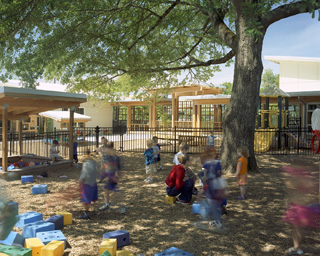|
Subscribe / Renew |
|
|
Contact Us |
|
| ► Subscribe to our Free Weekly Newsletter | |
| home | Welcome, sign in or click here to subscribe. | login |
Construction
| |
 |
July 22, 2010
Young children need room to stretch their minds
Mahlum Architects

Reifert
|
Children begin learning about themselves and their world at a remarkably early age, a fact that has far-reaching ramifications for those responsible for designing environments for early childhood learning.
The earlier a brain is exposed to a variety of positive experiences the more malleable it seems to be when shaping its responses to external factors. One neuroscientist likens this early exposure to setting a thermostat with a wide operating range of situations that will arise in future.
Even if a child has encountered deprivation or abuse at an early age, the young brain still has enough plasticity that it can respond well if the environment fosters creative problem solving, exposure to nature and positive interactions with others.
Although many factors come into play in designing for early childhood development, there are four considerations that heavily influence such designs. Our firm has worked with Larry MacMillan, an early learning development consultant, in helping clients clarify these areas.
Testing limits
Children are born to learn by moving and doing. In our risk-averse society, parents sometimes feel their offspring should never climb a tree or fall down or otherwise encounter a challenge. Consequently children are denied the ability to test their limits.
Not so in one kindergarten in Tachikawa, Japan, which has an oval-shaped roof that’s also an elevated play area enclosed on both sides by railings.
Children are allowed to climb the branches that grow up through the roof and, should they slip, there is a sturdy rope net that catches them. The children can sit on the edge of the roof, put their feet through the railings, and look safely down into the playground courtyard below, listen to mini-concerts or hear the head of the kindergarten make a speech.
Outdoor play areas give children more space to use their whole body or to engage in activities that are loud or messy. They can have a greater feeling of freedom and opportunities for more creativity. In fact, research indicates that the natural environment promotes more constructive play.
Children benefit from being exposed to the feel of wind on their bodies and to environments that allow them to walk, run, even fall. Unfortunately, apprehensive administrators sometimes draw back from providing the kinds of learning outdoor experiences that could be helpful to children.
Creating comfort
Those designing environments for early childhood seek a balance between predictability and stimulation, thus creating comfort. Books and playthings should be at the child’s level, along with opportunities for the child to test the limits between order and the unknown.
For example, it’s helpful for children to understand early how they relate to their environment. They need to be able to turn a water tap on and off, to close a door or window if there is a draft or to turn on a light if the room is dark.
But young children also need to be able to trust their world, to know they can see an adult, to know someone is there if they feel the need to be held or fed or otherwise comforted.
Developing competence
Toys and books need to be well-organized and accessible to capture the attention of the child, invite use and help clarify ideas and knowledge. There needs to be a variety of things to do, tasks that challenge a child and at which they can succeed, which stimulates competence.
Countertops, doors and windows should be built at children’s heights. Reducing the scale of a room or play area helps support the perception of possibilities as well as limits. Having age-appropriate challenges that can be overcome gives the child an opportunity to build self-esteem.
An early childhood center now being designed at Mt. Hood Community College will have angled ceilings to reduce the perceived room height to create a space in scale appropriate for 3- to 5-year-olds. Deep walls will allow for benches, and child-height windowsills will accommodate plants.
Young children need to have ways to perfect their balance skills so they can learn to walk, run, jump and climb. Environments for toddlers consequently need to incorporate soft and rounded corners, and equipment must be sized appropriately.
Learning self-control
Spaces should be predictable so children can figure out their use, but also connected so that a child can move easily from one area to another, which promotes self-control. There should be an area where children can be private or quietly observe before they decide to join in play.
By following a built-in order, a child can move to different levels of experience, and in so doing, learn and grow in a logical way.
Exposure to nature
Beyond the major considerations of fostering movement, comfort, competence and self control, a myriad of factors also influences the ultimate design of an early learning center — exposure to natural light; access to different smells and sights; and opportunities for touching bark, grass and water.
The Mt. Hood childcare center will feature a meandering internal “street” that opens and widens to form plazas, squares, nooks for indoor activities, as well as outdoor play areas. One idea under consideration is a “farm” and possible chicken coop. Another will be accessed through an indoor wet-play area that can also act as a cleaning or changing room.
Early childhood educators are increasingly committed to starting environmental education at very young ages because research indicates that empathy toward the natural world develops best when there’s free access to nature. Outdoor environments reinforce a child’s independence and gives him or her the chance to learn to be more independent.
A design team for the Moss Street Children’s Center at the University of Oregon preserved two large trees — an old eastern water oak and a ponderosa pine — and created a rock-filled stream bed in the play area to provide a natural learning environment.
By contrast, there is some evidence to suggest that if children are not given opportunities to interact with nature, then as adults they are often uncomfortable in natural places and may even actively dislike environments that are not man-made.
It then falls to us as designers, educators and parents to provide stimulating, affirming environments that enable children to reach their full potential even into adulthood.
Butch Reifert is the managing partner for Mahlum, an architectural firm founded in 1938 that specializes in designing learning environments from early learning to post secondary.
Other Stories:
- Let a developer build your school
- School pilot project could affect county stormwater rules
- Putting ‘community’ into community college campuses
- Designing for early childhood education: What works?
- Why are school construction costs so low?
- Find out if your school is fit for a retrofit
- Give students a say on their school design
- Student-centered schools put learning first
- Industry takes a leading role in new skills center
- Site headaches can be a gift for students
- Money’s tight, so how about a living building?



